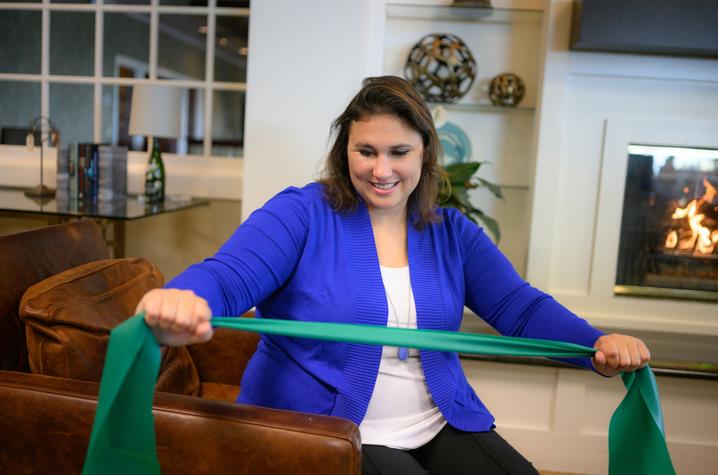UK researcher explores multisensory approach as potential treatment for Alzheimer’s patients

A CD player. Lavender-infused lotion. A weighted blanket. A roll of red tape. The last things you’d expect when it comes to Alzheimer’s care. But every item was chosen for a specific purpose: to help care for a person with Alzheimer’s disease and related dementias (ADRD) through their sense of hearing, smell, feel, sight and more.
“Aging dramatically alters and decreases the effectiveness of sensory modalities in our body to take in information. Our hearing gets worse, our vision gets worse, our balance, our touch — our sensory systems just degrade. Enhancing sensory input through the body is one way to soothe and nourish the brain,” said Elizabeth Rhodus, Ph.D., assistant professor in the University of Kentucky’s Sanders-Brown Center on Aging, Department of Behavioral Science and primary faculty of the Center for Health Equity Transformation.
The focus of Rhodus’ work is to enhance sensory input in order to improve behavioral symptoms in people with ADRD. This approach doesn’t involve medication but instead simple sensory changes in their home environment. Sensory stimulation occurs when one or more of the following senses is activated: vision, hearing, touch, smell, taste, pressure, movement and internal feelings. With the help of basic tools and materials, caregivers can stimulate these senses in adults with dementia in ways that can make them feel safer, happier and more comfortable.
That could mean offering a loved one a weighted lap pad to calm and regulate their nervous system, playing a familiar song to soothe anxiety, or placing red tape in important places around the home for increased visual recognition.
It is an approach that the National Institute on Aging (NIA) of the National Institutes of Health (NIH) has supported. Rhodus was recently awarded a K23 grant from the NIA titled “Improving Person-Environment Fit of Community-Residing Older Adults with Dementia Through Assessment and Individualized Intervention.” With this award, Rhodus will continue research aimed to assess and intervene on basic mechanisms between persons living with ADRD and the home environment, and mechanisms that may contribute to or minimize challenging behavioral symptoms of ADRD.
This is all a natural progression from Rhodus’ NIH T32 postdoctoral training in ADRD clinical trials with Sanders-Brown’s Gregory Jicha, M.D., Ph.D., and recent completion of the successful Harmony at H.O.M.E. (Help Online Modifying the Environment) project with Allison Gibson, Ph.D., of the College of Social Work, that was supported by the NIH and the Emory Roybal Center for Dementia Caregiver Mastery.
Harmony at H.O.M.E. offered a six-week telehealth program in which participating caregivers met virtually with a licensed occupational therapist once a week to discuss behaviors, interventions and modifications for each person with dementia. The program provided training and practical tools for caregivers to help improve the daily life of the person with dementia.
Every caregiving situation is different, and the program is personalized for the individual needs of each person and caregiver. Designed in conversation with caregivers, the goal is always to make the person with dementia feel safe, happy and comfortable.
“At every stage and every step, we have to respect the personhood and autonomy of older adults to make their decisions,” said Rhodus. “But we also integrate where they’re at in the disease process and what they need from a neurological perspective.
“Our goal is to empower caregivers to feel comfortable and competent in recognizing behaviors as a way to communicate,” she said. “By providing caregivers with training and tools, they can do simple modifiable things in their environment to help support behavior and activity participation for the person for whom they provide care.”
Telehealth programs like Harmony at H.O.M.E. are particularly relevant for people living in rural communities, where access to health care and caregiver support is not always available.
While this multisensory approach to caregiving is still very much an emerging idea, Rhodus says there is a reason the NIH is paying increasingly close attention to the relationship between sensory processing and dementia. For instance, NIH studies have found that people with cataracts who have low vision, as well as those with low hearing, have a higher risk of developing dementia. And while there’s still no cure for Alzheimer’s disease, early diagnosis and advances in treatment can offer hope for a better quality of life for those living with this devastating condition.
“There’s been a continual upward trajectory in how we’re caring for people,” said Rhodus. “We’re seeing longer life expectancies and better outcomes clinically for individuals living with dementia. At Sanders-Brown, we have numerous research projects aimed to develop new medications to treat and cure Alzheimer’s disease. We don’t have a cure yet, but we do have treatments that may slow the progression — and behavioral interventions that can lead to better quality of life.”
The long-term goal is to empower older adults with dementia to age in place, within their home, with minimal behavior disruption and maximum activity participation to honor and respect the dignity and self-worth of the person.
Research reported in this publication was supported by the National Institute on Aging of the National Institutes of Health under Award Number K23AG075262. The content is solely the responsibility of the authors and does not necessarily represent the official views of the National Institutes of Health.
More from this series Research Priorities - Neuroscience
Credits
Words: Hillary Smith
Photo: Adam Padgett


